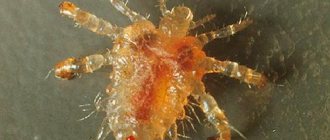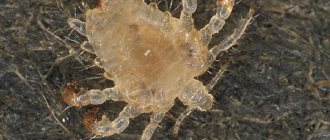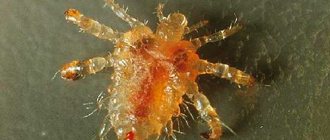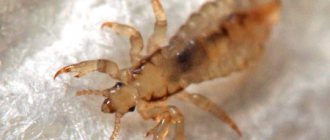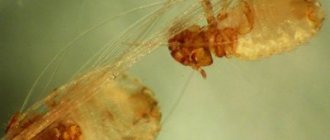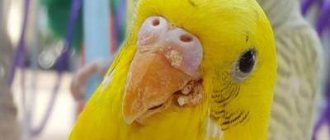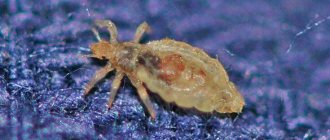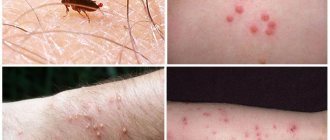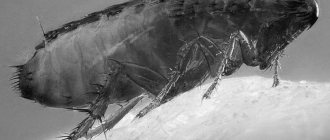Poultry farming » Chickens
0
3915
Article rating
Kira Stoletova
Parasites in chickens are a threat that must be eliminated urgently. Unpleasant symptoms of parasitic diseases torment the bird, making it weak and aggressive.
Parasites in chickens
If parasites are in eggs, even humans can become infected from food. How to treat a chicken coop against parasites and what prevention will help avoid problems with birds in the farmyard?
Parasitic diseases in poultry
Insects in chickens can affect other birds living in the vicinity of the sick individual.
Cleaning the chicken coop and enclosures is the primary task of the farmer and novice poultry farmer. Every person who raises low-maintenance pets should know how to treat a chicken coop for parasites.
The chicken coop is treated for parasites using special disinfectants. The person carrying out this type of cleaning must protect themselves from contact of chemicals with the skin and respiratory tract. Several types of insects can live in a chicken enclosure. Birds exposed to repeated bites behave aggressively and lose weight quickly. From bites, wounds appear on the body of chickens, which the bird combs. Open wounds are a favorable environment for the proliferation of pathogenic microorganisms and bacteria. If careful cleaning is not carried out, the chicken coop remains a dangerous place for chickens to live.
Chickens' entire body weakens from parasites. The meat and eggs of winged animals may contain dangerous substances that can harm humans. The poultry house must be treated simultaneously with pest control. Drug treatment helps against parasites of various types and types. The chicken coop is cleaned without the birds, which it is better not to expose to additional danger. In the chicken enclosure, the bedding and wall upholstery are changed. To prevent parasites from appearing in poultry meat and eggs in a home chicken coop, it is necessary to organize urgent integrated pest control.
Preventive measures
In order to prevent external and internal infection, you should strictly adhere to a simple rule - timely cleaning of poultry houses, disinfestation using lime, potassium, and potassium permanganate. Regular inspection of animals is also necessary. If an infestation is detected in the early stages, it will be easier to treat the livestock, which will reduce losses. Baths with sand and ash must also be placed in the yard.
New flocks of birds are subject to mandatory deworming. There are also recommendations according to which preventive removal of worms should be carried out at least in spring and autumn.
Variety of parasites
Different drugs help only against certain types of insects. A disease caused by pests that lead a parasitic lifestyle can be cured in a matter of days if you do not waste precious time. The first symptoms of the disease will help you make an accurate diagnosis and quickly get rid of the disease. It is impossible to use drugs without identifying the type of parasite in laying hens: the wrong drugs can harm the bird, which has weakened after suffering from an illness. Insects can pass from animal to person. Preparations for treating chicken coops help quickly remove infection and can protect the farmer and his family from parasitic diseases.
In a chicken enclosure, insects nest in crevices and secluded dark places. Without cleaning the area where the birds live, it will not be possible to completely get rid of them. To choose drugs, you need to decide on the type of pest. What insects threaten chickens? The fight is carried out against insects that infect adults and young animals:
- chicken flea, louse;
- lice eaters;
- pereaters;
- mallophages.
A chicken coop is a potentially dangerous environment for guinea fowl, geese or turkeys. The appearance of lice and other dangerous organisms is not uncommon. It is important to protect all domesticated winged animals (you can see the appearance of the pest in more detail in the photo). Infection occurs within a few days. Pests quickly spread from one sick individual to a healthy chicken. Even an experienced farmer will not be able to prevent mass infection. Pest control for pets is carried out as soon as the winged one shows the first symptoms of lice bites or nervousness. Do not dilute medications without instructions or without examination by a veterinarian. Every nook and cranny of your chicken enclosure needs to be cleaned.
Being able to protect a flock of domesticated birds, whose meat and eggs quickly infest pests, and not taking emergency measures is the biggest mistake of a poultry farmer. If at the initial stages of a parasitic disease there are no pests in the meat, then over time, harm from the effects of insect pests affects the quality of food obtained from pets (in meat or eggs). Chicken parasites and lice are inconspicuous pests without wings. The rounded segmented body is difficult to see, and it will not be possible to catch it on the body of the animal at all.
Description of the pest
Appearance
The chicken parasite is very similar in appearance to dog or cat fleas. Although biologically these are different species. The body of this pest, unlike other species, is flattened on both sides and divided into three parts: a head with two eyes and a pair of antennae, a thoracic region where three pairs of legs are located, and a large abdomen. Typically the insect is brown or black in color, depending on the species. The body is covered with a dense chitinous cover; on the surface of the cover there are irregularities and hairs, with the help of which the flea is attached to the feathers. The oral apparatus has a piercing-sucking structure. The hind pair of legs is highly developed, which allows fleas to push off and jump over vast distances, so the insect can make a jump of up to 1.5 m in length.
Varieties of chicken fleas
In total, there are more than 2 thousand different types of fleas. There are mainly two species that live on poultry.
- Chicken flea. Slightly larger than the black flea, reaching a length of 2-2.5 mm. The body is brown. The most common type of flea on poultry. Can attack humans and animals. It is believed that the pest initially appeared on tits, and only then settled on poultry. Unlike other species, it does not require a blood meal before mating.
- Black flea. It reaches 1.5 mm in length, the body is black. Most often lives in excrement. Capable of biting mammals and humans.
Features of reproduction and lifestyle
These parasites are quite heat-loving; temperatures around 40 degrees are most comfortable for them. Exactly what temperature is maintained under the feathers of chickens, allowing insects to live and reproduce in comfort. Also, good conditions for the development of parasites include high humidity, lack of ventilation, and accumulation of dirt and debris. Fleas feed on the blood of the victim, choosing areas of the body where the skin is especially thin and blood vessels are located close to the skin. These parasites, unlike ticks, do not inject an anesthetic into the blood, so their bites are very painful, which is why the insects greatly annoy poultry.
Chicken flea
The female lays eggs daily, pushing them out of her abdomen while jumping. Thanks to this, the eggs scatter throughout the chicken coop. Especially a lot of them accumulate in nests. In this way, a female can lay up to 40 eggs per day. The eggs are microscopic white oval grains. After about a week, the eggs hatch into worm-like larvae. They live mainly in nests and litter, feeding on excrement, leftover bird food, and skin particles. The larvae are afraid of light, so they hide in dark, secluded places. In this way, the larvae exist for 7-10 days, then they entangle themselves in a web, turning into a pupa. Pests remain in the pupal state until they find a suitable victim. This stage can last up to several months. Once on the victim, the pupa turns into an imago. In the adult stage, the insect lives from 2 to 12 months.
Chicken lice in chickens
A person can suffer from chicken lice. Infected birds carry up to a dozen pests that are looking for a new host for a parasitic lifestyle. In total, up to 2000 mallophages are distinguished in nature. The color of the parasite, brown and dark gray, does not stand out against the background of the plumage of hens or roosters. The massive head of the flea is larger than the entire elongated body. The total size of the pest is no more than 2 mm. However, subtle parasites cause significant damage.
An effective remedy that will help get rid of insects is available in the form of aerosols or liquid substances.
Such products can completely cover the plumage of an infected bird. Birds react sharply to skin injuries: they become aggressive and harm themselves while trying to scratch the bite site. A bird cannot get rid of lice on its own. A caring poultry farmer can remove the parasite. A photo of an infected bird without treatment demonstrates how deplorable the condition of an infected bird can be without any action aimed at improving the situation.
The first symptoms, when chickens itch and lose weight, are an alarming sign for the poultry farmer. Such signs can cause death in chicken livestock. Treatment of farm pets and treatment of the chicken coop are two simple methods of controlling parasites in a chicken flock.
If traditional methods do not help
When the scale of the damage is too great, folk remedies are no longer enough. We have to use chemicals. Please note that veterinary advice is required. Before using drugs from the chicken coop, it is necessary to remove old bedding, droppings, and clean all places where there may be accumulations of insects.
The drugs are available in various forms: drops, sprays, injections, concentrates, powders. Sometimes pet products help. The most common drugs are the following.
Sprays and aerosols
Spray the skin and feathers to make them moist. If necessary, the procedure can be repeated.
- Hartz. Typically used on dogs and cats, but effective against chicken species of ectoparasites. Effective for a month. Do not wash off with water or rain.
- Beaphar. The company has a separate line of products for birds. The spray is a colorless liquid with a faint pyrethrin odor that repels pests. For greater effect, you need to re-spray the feathers after two weeks.
- Frontline. Typically used against parasites on dogs and cats. Spray the feathers to make them moist. If necessary, you can repeat the procedure.
Drops
Drops are usually applied to the back of the head, just like for animals.
- Leopard. As a rule, it does not cause allergies. For chickens, 10 drops are enough. Repeated treatment, if necessary, can be carried out after a month.
- Advantage. The active ingredient is imidacloprid. Dosage for chickens: one pipette. Repeated treatment, if necessary, can be done after 1.5 months.
Powders
Among powders, products based on deltamethrin are excellent. Deltamethrin is a highly toxic drug, has a nerve-paralytic effect, blocks nerve impulses in parasites, as a result of which they die.
The chicken coop also needs to be treated. The drugs Diazinon, Stomazan, and Tsifox are suitable for this purpose. The product must be diluted with water and sprayed into the room, paying attention to corners, joints and other places where insects can accumulate. After treatment, the room is left closed for several hours, then ventilated and washed.
Bird symptoms and treatment
Down feather eaters affect birds of different ages and breeds. Young animals are more susceptible to insect attacks. Sick chickens infect healthy ones, and without proper attention, over time, the bitten birds begin to die. Not only the pets’ place of residence should be treated, but also the feeders, drinking bowls, and equipment used by the farmer.
For young animals and laying hens, attacks by mallophages are a great stress. The egg production of the bird decreases, and the brood does not gain weight well. The first symptoms appear in young animals. The treatment of enclosures of growing individuals is carried out first. All farm pets are treated separately. It is not worth keeping infected birds in uncleaned enclosures, otherwise repeated attacks cannot be avoided.
Sources of infection can be bird cages, nests and food. Even dust storms bring parasite eggs into the poultry house. Roosters become infected with lice more often, so they are the first to bring the mallophage into the domesticated flock. They carry dozens of lice every day. The peak of the disease is spring or autumn, when lice can multiply quickly and are not afraid of sudden temperature changes. Lice hide under the wings or in the plumage of a bird, because mallophages are afraid of bright light.
Treatment of animals involves treatment with insecticides. Not only the poultry, but the entire area of the chicken coop is sprayed with the solution. Using a sprayer, distributing the solution is much easier. All plumage is completely saturated with anti-lice substances. All animals should be treated at once. Powders are rarely used to clean chicken flocks, but such products can also help in the fight against parasites. Solutions should not come into contact with the bird's eyes or mouth. Processing of chickens in cages can only be carried out by an experienced farmer who will not harm the birds. A person who has been raising farm pets for a long time can improve the quality of life for their animals.
Where do fleas come from in a chicken coop?
Accumulations of debris and dirt are suitable conditions for fleas to breed. Untimely removal of droppings, dirty bedding, old food - all this contributes to the spread of pests, and in such living conditions, chickens' immunity is reduced, which leads to various diseases.
- The most common ways insects get into a chicken coop are as follows.
- Adding infected individuals to the chicken coop. Sometimes unscrupulous poultry farmers can sell birds with parasites. Therefore, when purchasing chicks, you must check them.
- With the help of a person. A person himself can bring pests from other farms or subsidiary plots on his clothes.
- With bedding. New bedding, such as straw, can also harbor fleas, which then move onto the chickens.
- From wild birds. Wild birds, such as pigeons or sparrows, can also carry fleas. They can also cause chicken fleas to appear in an apartment.

